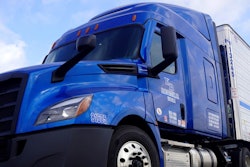Trucking size and weight rules have been frozen in time for decades as other modes of freight have evolved. It’s time to rethink Long Combination Vehicles (LCVs) and heavier, longer single trucks in light of technology and real-world experience.
Evergreen’s A-class container ships are reportedly the largest in the world at more 400m (1312’) long with a 61.5m (202’) beam and capable of carrying in more than 24,000 TEUs (20’ ocean-going containers). To put that in perspective, laid end to end, one shipload of containers represents 90 miles of freight. This massive amount of freight is managed by a crew of about 25.
A Boeing 747-8F commercial freight plane has a payload capacity of 132,600 kg (292,400 lbs.), which is equivalent to the freight carried by approximately six heavily loaded U.S. day cabs. This is managed by a crew of two pilots.
The Burlington Northern Santa Fe (BNSF) regularly runs consists (the term describing a train and cars) in excess of 275 cars, exceeding 5,500m (18,000’) in length, transporting more than 500 double stacked 53’ intermodal containers. These consists pulled by six or more engines have an on-board crew of two.
To put these three in terms of freight weight carried per crew member:
- The A-class ship is 9,423 tons/person.
- The 747 plane is 73 tons/person.
- The intermodal train is approximately 10,000 tons/person.
Since the 1940s, each of these commercial freight modes has evolved considerably. Technology innovation is certainly part of the reason, but more critically, the endless pursuit of cost reduction has been instrumental in enabling this growth in capacity per vehicle and capacity per crew member.
Trucking freight per vehicle and freight per crew member has remained largely unchanged since Jimmy Carter’s presidency. A beverage hauler or bulk hauler operating a day cab and 53’ dry van trailer might weigh out at 50,000 lbs. At some ports, a drayage truck might see 36,000 lbs. container on a single chassis while at other ports, weights might be as high as 50,000 lbs. For arguments sake, let’s say that is 25 tons/person.
The media is overflowing with daily reports of the potential of autonomous vehicles, the phrase “driverless” is starting to show up more often. Whether cars or commercial vehicles, the growing impression is that vehicles will safely navigate themselves in the future.
Today’s technology for driver assistance such as automatic lane keeping, collision avoidance, blind spot monitoring, adaptive cruise control and automatic braking is leaps and bounds beyond where cars and trucks were in 1980.
Yet there is no significant effort to increase payload per truck or payload per driver. The other transportation modes have made phenomenal efficiency gains. So why are trucks stuck in the past?
There are U.S. regional pockets of improvement such as states like Washington, Oregon, Idaho and Nevada where triple 28’ trailers can be seen being pulled by day cabs, and sometimes double 53’ ones. There are states like Michigan and Washington State where three- and four-axle trailers are being pulled by tractors equipped with drop axles, making seven- or eight-axle trucks capable of carrying payloads of 120,000 lbs. to perhaps 140,000 lbs. Some turnpike corridors in Florida allow double 53’ trailers and, near ports, Texas allows vehicles with GVWs of up to 93,000 lbs. to operate. In some states you can regularly see trailers longer than 53’.
If automation is going to be so safe, what does it matter how long trucks are? If multiple axles can work in many regions in the U.S., why limit the majority of trailers to be two axles and the majority of trucks to be 6x4 or 4x2?
If on-road technology is going to improve safety, why can’t on-road technology also improve freight efficiency?
In 2016, I suggested that a fully autonomous truck might not need a cab for humans at all. The space and weight freed up by removing the cab above the truck’s rails would permit longer trailers with greater cube potential. Going to three axle trailers — common in Europe and Australia — would permit greater cargo weights. Using drop axles on tractors also could improve cargo weight capacity.
If an autonomous truck is going to be operating anyway, why not have it pull more than one trailer? If an autonomous single tractor-trailer is going to be deemed safe on the roads, what is stopping technologists from making a double or triple just as safe?
We live in a world of possibilities that every day show us the impossible is actually possible.
Changing the status quo is sacrilege, I know.
The argument for longer, heavier vehicles has been made repeatedly in the past documented in reports by the Transportation Research Board going back to before 1986. The 21st Century Truck partnership has published several reports in the National Academies Press mentioning the potential of LCVs in the last two decades. RMI did an extensive analysis of the potential of LCVs in a report published in 2008.
It seems to me that vested interests seem to prevail to maintain the status quo, tossing around arguments that safety will be an issue, or jobs will be an issue, or road repair will be an issue. Yet each of those arguments can be deflated looking at actual LCV use in the U.S., Canada, Australia, and parts of Europe.
Cars cause a significant number of accidents involving trucks. If car technology is allowing safe autonomous driving, what does it matter how big or how long the trucks are? Safer cars inherently make trucking safer.
Truck accident rates are tied to the number of vehicles on the road at any time. LCVs have a positive impact on reducing the number of vehicles at risk at any moment in time.
There is no single answer to improving freight efficiency in the U.S. A range of technology improvements and operational practice improvements are needed to get more freight moved for less money, less energy, less accidents, less delays, etc.
LCVs and longer, heavier single trucks need to be part of the future solution space to hauling more freight more efficiently and safely.










